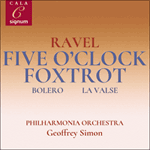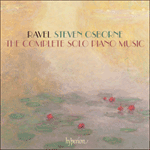
Welcome to Hyperion Records, an independent British classical label devoted to presenting high-quality recordings of music of all styles and from all periods from the twelfth century to the twenty-first.
Hyperion offers both CDs, and downloads in a number of formats. The site is also available in several languages.
Please use the dropdown buttons to set your preferred options, or use the checkbox to accept the defaults.

from notes by Roger Nichols © 2011
extrait des notes rédigées par Roger Nichols © 2011
Français: Marie-Stella Pâris
aus dem Begleittext von Roger Nichols © 2011
Deutsch: Viola Scheffel
 Debussy & Ravel: Debussy & Ravel for two Debussy & Ravel: Debussy & Ravel for twoA rich programme incorporating two classics of the genre, several less well known arrangements of Debussy (including by Dutilleux and Ravel, no less) and culminating in Ravel's riotous 'La valse', heard here in the two-piano version which came bef ...» More |
 Ravel: Five o'clock foxtrot & other orchestral works Ravel: Five o'clock foxtrot & other orchestral works'Five o'clock foxtrot' (as the ragtime sequence from Ravel's opera 'L’enfant et les sortilèges' came to be known in the 1930s when various dance bands took it up as an instrumental number) sets the scene for a glorious programme of the composer at ...» More |
 Ravel: The Complete Solo Piano Music Ravel: The Complete Solo Piano MusicNew releases of Steven Osborne’s best-selling discs have become some of the most eagerly awaited events in the pianophile diary. This most delicate and subtle of musicians also displays a pyrotechnical deployment of digital acrobatics, mesmerizing ...» More |

